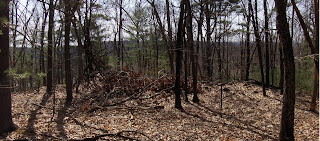Sunday night I lay in bed listening to the drumming of the pounding rain on the roof of my house. After a long spell of very dry weather, finally a good rainstorm. I imagined the heavy rains churning up the earth, creating washouts and gullies and exposing tools buried for thousands of years. I had been waiting for a rain like this. I was so thrilled by the storm that I found it hard to fall asleep despite the soothing sound of the rain and the cool breeze coming through the window.
Monday I drove to work and watched the raindrops splashing in the puddles with great interest. My anticipation grew all day and after it stopped raining it became almost unbearable. After work I raced to a place where I could walk. The conditions were great, lots of rocks clearly visible, freshly exposed, washed clean by the rain and standing in sharp contrast to the soaked earth. Perfect. I carefully examined every broken rock, every color and shape. I was pleased to see this lying totally exposed:
I believe this is what is called a "small stemmed" or "Squibnocket stemmed" point, made of argillite. Most points of this shape were made of quartz. This one is damaged, missing the tip. For me this is a good find because I like this shape and also the material, despite the fact that this material appears soft and results in rather crude tools for the most part.
I looked at many more rocks in this spot but didn't find any other tools. I walked to another area with fewer rocks visible and saw a very exciting shape about 10 feet away, big, totally exposed and looking far too good to be true. Could it be? I couldn't believe my eyes...
This is one of the best things I have ever found, it is perfect, thin, slightly serrated, the workmanship is incredible. And it certainly was not hard to spot. I was very lucky to be in the right place at the right time, to be the one to find this gem after all these years.
On the way back to the car as the sun was setting I reached down to pick up a piece of quartz that was just barely peeking out of the ground. I wiped the mud off and was very surprised when this emerged:
This is chunky and thick, steeply beveled on one side, probably reworked down from a larger blade and perhaps used as a knife. I was very, very lucky yesterday. I spend so many hours looking and coming home with nothing but a stiff neck and aching back and it is easy to get discouraged but a day like yesterday makes it all worth it. Here are the finds for the day after I cleaned them up.


















































